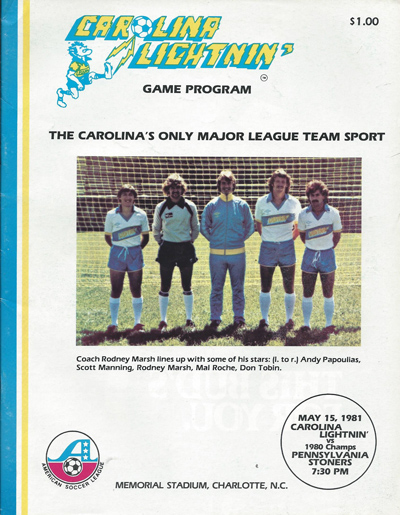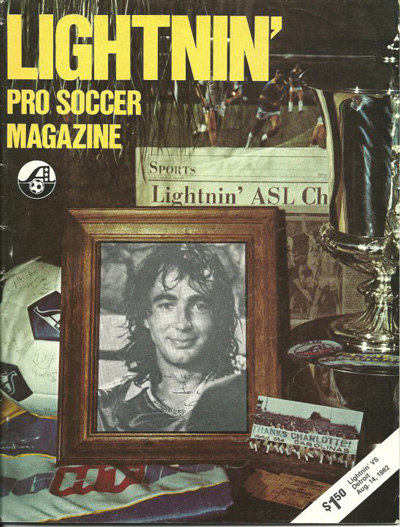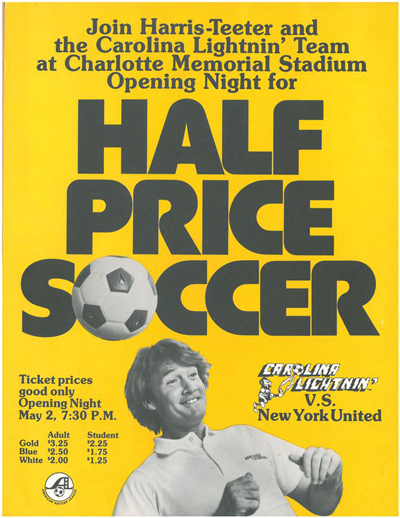American Soccer League (1981-1983)
Tombstone
Born: December 6, 1979 – ASL expansion franchise1ASSOCIATED PRESS. “Charlotte Gets ASL Team”. The Herald-Sun (Durham, NC). December 7, 1979
Folded: October 18, 19832Scott, David. “Lightnin’ Won’t Strike In 1984”. The Observer (Charlotte, NC). October 19, 1984
First Game: May 2, 1981 (T 2-2 vs. New York United)
Last Game: August 13, 1983 (L 2-0 and L 2-0 [mini-game] @ Jacksonville Tea Men)
American Soccer League Champions: 1981
Stadium
American Legion Memorial Stadium (24,166)31983 American Soccer League Media Guide
Opened: 1936
Marketing
Team Colors: Sky Blue, Gold & White41983 American Soccer League Media Guide
Ownership
Owner: Robert Benson
ASL Expansion Fee (1979): $250,0005ASSOCIATED PRESS. “Charlotte Gets ASL Team”. The Herald-Sun (Durham, NC). December 7, 1979
Attendance
These are unofficial counts of Carolina Lightnin’ attendance reconstructed from complete sets of regular season game reports & box scores from the 1981, 1982 and 1983 seasons. Exhibition and playoff games were not included in the count.
For example, this means the Lightnin’s massive announced crowd of 20,163 for the 1981 ASL championship game at Memorial Stadium is not reflected in these figures.
Tilting your mobile device may offer better viewing.
Primary Sources:
- Reconstructed from Charlotte Observer game stories (1981-1983 Lightnin’ figures)
- Lewis, Michael. “Flash finish 3rd in attendance”. The Democrat & Chronicle (Rochester, NY). September 10, 1981 (1981 ASL league wide figure)
Alternate/Unused Sources:
- Soccer Monthly pegged Carolina’s 1981 average regular season attendance at 5,187 compared to our box score count of 5,300. 6Taylor Quirk, Beatrice. “Nothin’ Could Be Finer Than To Be In Carolina”. Soccer Monthly. November 1981.
- Rochester Democrat & Chronicle has 1981 Lightnin’ attendance average at 5,3257Lewis, Michael. “Flash finish 3rd in attendance”. The Democrat & Chronicle (Rochester, NY). September 10, 1981
Background
The Carolina Lightnin’ were a popular 2nd division soccer club that played three seasons in Charlotte during the early 1980’s. They were the first pro soccer franchise ever established in the Carolinas.
Founded as an American Soccer League expansion club in December 1979, the club debuted a year-and-a-half later in April 1981. In the interim, the Lightnin’ made a key acquisition, signing recently retired English soccer star Rodney Marsh as Head Coach in September 1980. Marsh, a long-time star for Queens Park Rangers and Manchester City, came to the United States in 1976 to play for the Tampa Bay Rowdies of the North American Soccer League. The Rowdies were a big draw at the time and Marsh’s shaggy hair and magnetic personality made him a media star, by the modest standards of American pro soccer at the time. Marsh even had his own Miller Lite TV spot in 1980:
Marsh retired as a player in September 1979 following the Rowdies loss to the Vancouver Whitecaps in Soccer Bowl ’79. He decided to stay in the States and become a coach, hooking on with New York United of the American Soccer League in 1980. United were attempting an ambitious move in to Shea Stadium, home of the New York Mets, that summer. It was an odd venue for an anonymous minor league soccer team and United played to acres of empty grandstands. Marsh separated from the team at mid-season, but latched on with Carolina a few months later and found a much happier circumstance.
Building a Champion
The Lightnin’ took advantage of the American Soccer League’s annual disarray and financial distress to pilfer other clubs for many of the 2nd division’s top players. Carolina landed Mal Roche, the league’s top scorer in 1980 whose previous club had disbanded. Playmaking midfielder Don Tobin was a league All-Star but, like Roche, became available when his former employer folded. Goalkeeper Scott Manning was the best netminder in the ASL in 1980, but Carolina snatched him away from the Pennsylvania Stoners franchise nonetheless.
The club’s most remarkable find was Tony Suarez, a Cuban who moved to Charlotte at age 16. Suarez came to the team on a tryout with no prior pro experience. He failed to make the team but as a consolation was offered a job as the team’s bus driver and gofer. Injuries eventually opened a roster spot for Suarez, who promptly scored 9 goals in his first 12 pro matches. He ultimately led the Lightnin’ in scoring in 1981 (and finished 5th in the league) with 15 goals and 4 assists. He was named the ASL’s 1981 Rookie-of-the-Year.
1981 ASL Championship Game
The Lightnin’ won their division with a 16-9-3 record and made it through the playoffs to earn a date with Marsh’s former team, New York United, in the 1981 ASL Championship Game. United should have hosted by virtue of having the league’s best record at 19-5-4. But crowds remained dismal in New York, while expansion Carolina led the ASL with average crowds over 4,000 per match and a couple of late season gates in excess of 8,000. The league voted to move the September 18, 1981 championship match to Charlotte’s Memorial Stadium.
A strong crowd was expected, but Carolina shocked the American soccer scene when a league record 20,163 fans packed the stadium for the match. The game was deadlocked until the 64th minute when United’s Solomon Hilton beat Manning to give the visitors a 1-0 advantage. But Don Tobin tied the match on a header in the 69th minute to rally Carolina and send the game into overtime. Hugh O’Neill scored the game winner for Carolina in the second overtime period and Carolina had the league title.
1982 Season
In 1982, the Lightnin’ loaded up to defend their title. The club added 34-year Derek Smethurst, a deadly striker who scored 57 goals for Tampa Bay in the NASL, mostly while paired up top with Rodney Marsh. Smethurst’s skills were in decline at age 34 though and he only stuck around Carolina for a handful of games. The other big acquisition was English striker Paul Child. Like Smethurst, Child was one of the NASL’s all-time leading scorers, but was without an employer as America’s top pro league began a severe contraction at the beginning of the 1980’s.
One player who was missing was 1981 hero Tony Suarez. Suarez injured his leg playing indoor soccer with Cleveland Force and missed the entire 1982 outdoor season. His career never recovered and he was finished playing by 1984.
The 1982 Lightnin’ could not recapture the magic of their debut season. They finished 11-13-4 and their season ended with a semi-final series defeat at the hands of the Oklahoma City Slickers.
Demise of the ASL & The Lightnin’
In 1983 the Lightnin’ hired 42-year old Bobby Moore, the captain of England’s 1966 World Cup championship side, as an assistant coach. He later ended up appearing in some games as a player as well.
The Lightnin’ posted a losing record once again in 1983.
In early 1984, the entire American Soccer League folded after more than fifty years of operation. Owner Robert Benson withdrew his support for the team. Several ASL teams formed a new league called the United Soccer League. Charlotte received a USL franchise under new ownership and with a new name – the Charlotte Gold – for the 1984 season. Many former staff members and players from the Lightnin’ continued on with the Gold, who played one season and then went out of business in late 1984.
Voices
“<Carolina> had so many injuries they activated Bobby Moore to play that night against us. Bobby was probably 43 years old and he obviously can’t move. He’s kicking everything and everybody that he can get close to. And we’re just going “Oh my God – it’s Bobby Moore.”
I remember we had a 2-0 lead and we absolutely crumbled in the final ten minutes with their fans going nuts. They had probably about 7,000 or 8,000 fans in this cool little stadium in Charlotte. I think it was called the Memorial Stadium. We totally collapsed as a team and lost 3-2. I remember our owner on the bus back to the hotel and screaming at one of our players. I think a lot of us were just still in shock that Bobby Moore was playing that night.”
– Glenn Davis, Pennsylvania Stoners (2012 FWiL Interview)
In Memoriam
Assistant Coach/defender Bobby Moore (Lightnin’ ’83) died of cancer on February 24th, 1993 at the age of 51. New York Times obituary.
Forward Tony Suarez (Lightnin’ ’81 & ’83) passed away April 18, 2007 at the age of 51.
Downloads
5-15-1980 – Charlotte to Host 1980 ASL All-Star Game Press Release
5-15-1980 Charlotte to Host ASL All-Star Game
Links
Carolina Lightnin’ Alumni & Friends Facebook Page
###




